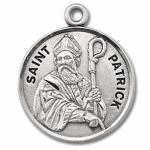It is said that on St. Patrick’s Day, there are only two types of people: those who are Irish and those who wish they were! We all know that St. Patrick’s Day is celebrated on March 17, but how much do we really know about the man himself?
St. Patrick was not born in Ireland. His parents were Romans who were living in Britain.
As a teenager, St. Patrick was kidnapped and taken to Ireland, where he was sold into slavery. It is thought that he was a slave for approximately six years.
During his enslavement, St. Patrick developed a strong faith in God and believed that one day his life would improve. Eventually, he was able to escape from Ireland and went back to Britain.
St. Patrick wanted to have his life centered around his religious beliefs, and he entered the priesthood. Later on, St. Patrick was made a bishop. He returned to Ireland in the year 433 AD.
Over the next several decades, he converted many of Ireland’s people to Christianity. He was also responsible for building a number of churches.
St. Patrick died on March 17 in the year 461 AD. There are differing accounts as to where his death took place, however. According to one version, he passed away at Saul in Ireland. Another version puts the place of St. Patrick’s passing at Glastonbury, England.
A number of places of worship around the world are named for St. Patrick. Cathedrals bearing his name can be found in New York, Dublin, and Toowoomba, Australia.
St. Patrick is known for having driven the snakes out of Ireland. He did accomplish this feat, but not in the way that you might think. Ireland doesn’t have any snakes, and likely never did.
Serpentine symbols were a part of the pagan religion. When the people adopted the Christian faith, they abandoned their previous religion and all of its symbolism. The “snakes” that St. Patrick drove out of Ireland were these religious icons.
When St. Patrick’s Day is observed on March 17, it is not only a day for celebrating all things Irish. It is also a day for offering prayers for all those who work as missionaries throughout the world.
The reason why the shamrock is associated with St. Patrick is that he used this tri-leafed plant to symbolize the Holy Trinity: the Father, the Son, and the Holy Spirit.
A traditional Irish blessing associated with St. Patrick is as follows:
May St. Patrick guard you wherever you go and guide you in whatever you do -- and may his loving protection be a blessing to you always.


